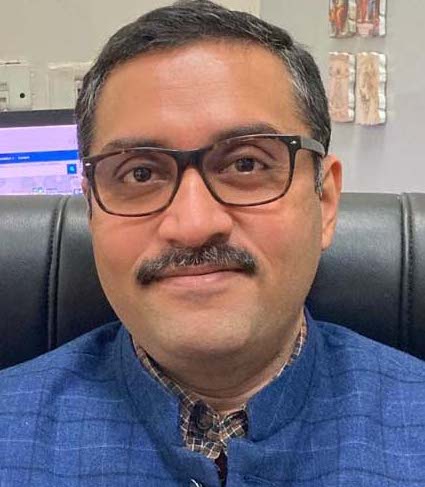Selected Publications
- Kaur D#, Verma P#, Singh M, Sharma A, Lata K, Mukhopadhaya A*, Chattopadhyay K*. (2022) Pore formation-independent cell death induced by a b-barrel pore-forming toxin. FASEB Journal. 36(10):e22557. doi: 10.1096/fj.202200788R. [#Equal contribution][*Joint corresponding authors].
- Mondal AK, Sengupta N, Singh M, Biswas R, Lata K, Lahiri I, Dutta S, Chattopadhyay K. (2022) Glu289 residue in the pore-forming motif of Vibrio cholerae cytolysin is important for efficient β-barrel pore formation. J Biol Chem. 298(10):102441. doi: 10.1016/j.jbc.2022.102441.
- Mishra S, Kundu N, Pramanick I, Kumar A, Chattopadhyay K, Dutta S. (2022) Structural insights into thermostable direct hemolysin of Vibrio parahaemolyticus using single-particle cryo-EM. Proteins. 2022 Aug 24. doi: 10.1002/prot.26416. Online ahead of print.
- Mondal, A. K., Lata, K., Singh, M., Chatterjee, S., Chauhan, A., Puravankara, S., Chattopadhyay, K. (2022) Cryo-EM elucidates mechanism of action of bacterial pore-forming toxins. Biochim Biophys Acta Biomembr. 1864(11):184013.
- Gupta, T.#, Mondal, A. K.#, Pani, I., Chattopadhyay, K.*, Pal, S. K.* (2022) Elucidating liquid crystal-aqueous interface for the study of cholesterol-mediated action of a b-barrel pore forming toxin. Soft Matter. 18(28):5293-5301. [#Equal contribution first authors; *Joint corresponding authors]
- Lata, K., Singh, M., Chatterjee, S., and Chattopadhyay, K. (2022) Membrane dynamics and remodelling in response to the action of the membrane-damaging pore-forming toxins. J. Membr. Biol. 255(2-3):161-173 .
- Singh, M., Rupesh, N., Pandit, S. B., and Chattopadhyay K. (2022) Curcumin Inhibits Membrane-Damaging Pore-Forming Function of the β-Barrel Pore-Forming Toxin Vibrio cholerae Cytolysin. Frontiers in Microbiology. 12:809782. doi: 10.3389/fmicb.2021.809782.
- Mondal, A.K. and Chattopadhyay, K. (2022) Structures and functions of the membrane-damaging pore-forming proteins. Advances in Protein Chemistry and Structural Biology. 128:241-288.
- Sengupta, N., Mondal, A. K., Mishra, S., Chattopadhyay, K., and Dutta, S.* (2021) Single particle Cryo-EM reveals conformational variability of the oligomeric VCC β-barrel pore in a lipid bilayer. Journal of Cell Biology. 220(12):e202102035. doi: 10.1083/jcb.202102035 [*Corresponding Author].
- Verma, P. and Chattopadhyay, K. (2021) Current Perspective on the Membrane-Damaging Action of Thermostable Direct Hemolysin, an Atypical Bacterial Pore-forming Toxin. Frontiers in Molecular Biosciences. Front. Mol. Biosci., 23 July 2021 | https://doi.org/10.3389/fmolb.2021.717147.
- Verma, P., Gandhi, S., Lata, K., Chattopadhyay, K. (2021) Pore-forming toxins in infection and immunity. Biochem. Soc. Trans. 49(1):455-465.
- Mondal, A. K., Verma, P., Sengupta, N., Dutta, S., Pandit, S. B., and Chattopadhyay, K. (2021) Tyrosine in the hinge region of the pore-forming motif regulates oligomeric beta-barrel pore formation by Vibrio cholerae cytolysin. Molecular Microbiology. 115(4):508-525.
- Mondal, A. K., Verma, P., Lata, K., Singh, M., Chatterjee, S., and Chattopadhyay, K. (2020) Sequence diversity in the pore-forming motifs of the membrane-damaging protein toxins. J. Membr. Biol. 253(5): 469-478.
- Kundu, N., Verma, P., Kumar, A., Dhar, V., Dutta, S., and Chattopadhyay, K. (2020) N-terminal region of Vibrio parahaemolyticus thermostable direct hemolysin regulates the membrane-damaging action of the toxin. Biochemistry. 59(4): 605-614.
- Mondal, A. K. and Chattopadhyay, K. (2020) Taking Toll on Membranes: Curious Cases of Bacterial β-Barrel Pore-Forming Toxins. Biochemistry. 59(2): 163-170. [This article is part of the Future of Biochemistry: The Asia-Pacific Issue special issue. ]
- Mondal, A. K., Sreekumar, A., Kundu, N., Kathuria, R., Verma, P., Gandhi, S., and Chattopadhyay, K. (2018) Structural Basis and Functional Implications of the Membrane Pore-Formation Mechanisms of Bacterial Pore-Forming Toxins. Adv Exp Med Biol. 1112, 281-291 .
- Kathuria, R., Mondal, A. K., Sharma, R., Bhattacharyya, S., and Chattopadhyay, K. (2018) Revisiting the role of cholesterol in regulating the pore-formation mechanism of Vibrio cholerae cytolysin, a membrane-damaging ß-barrel pore-forming toxin. Biochemical Journal 475 (19), 3039-3055.
- Kathuria R, and Chattopadhyay K. (2018) Vibrio cholerae cytolysin:Multiple facets of the membrane interaction mechanism of a β-barrel pore-forming toxin. IUBMB Life. 70(4): 260-266. [This review article was selected for the issue highlight].
- Kundu, N., Tichkule, S., Pandit, S. B., and Chattopadhyay, K. (2017) Disulphide bond restrains C-terminal Region of thermostable direct hemolysin during folding to promote oligomerization. Biochemical Journal 474 (2), 317-331.
- Rai, A. K., and Chattopadhyay, K. (2016) Revisiting the oligomerization mechanism of Vibrio cholerae cytolysin, a beta-barrel pore-forming toxin. Biochem. Biophys. Res. Com., 474 (3), 421-427.
- Khilwani, B., and Chattopadhyay, K. (2015) Signaling beyond punching holes: modulation of cellular responses by Vibrio cholerae cytolysin. Toxins, 7(8), 3344-3358.
- Rai. A. K., Kundu, N., and Chattopadhyay, K. (2015) Physicochemical constraints of elevated pH affect efficient membrane interaction and arrest an abortive membrane-bound oligomeric intermediate of the beta-barrel pore-forming toxin Vibrio cholerae cytolysin. Archives of Biochemistry and Biophysics. 583, 9-17.
- Rai, A. K., and Chattopadhyay, K. (2015) Revisiting the membrane interaction mechanism of a membrane-damaging β-barrel pore-forming toxin Vibrio cholerae cytolysin. Molecular Microbiology, 97(6), 1051-1062.
- Lata, K., and Chattopadhyay, K. (2015) Helicobacter pylori TlyA Forms Amyloid-like Aggregates with Potent Cytotoxic Activity. Biochemistry, 54 (23), 3649-3659.
- Khilwani, B., Mukhopadhaya, A.*, and Chattopadhyay, K.* (2015) Transmembrane Oligomeric form of Vibrio cholerae Cytolysin Triggers TLR2/TLR6-dependent Pro-inflammatory Responses in Monocytes and Macrophages. Biochemical Journal, 466 (1), 147-161. [*Joint Corresponding Authors]
- Rai, A. K., and Chattopadhyay, K. (2015) Vibrio cholerae cytolysin: structure-function mechanism of an atypical β-barrel pore-forming toxin. Adv. Exp. Med. Biol, 842, 109-125.
- Lata, K. and Chattopadhyay, K. (2014) Helicobacter pylori TlyA agglutinates liposomes, and induces fusion and permeabilization of the liposome membranes. Biochemistry, 53 (22), 3553-3563.
- Rai, A. K., and Chattopadhyay, K. (2014) Trapping of Vibrio cholerae Cytolysin in the Membrane-bound Monomeric State Blocks Membrane Insertion and Functional Pore Formation by the Toxin. J. Biol. Chem, 289 (24), 16978-16987.
- Lata, K, Paul, K., and Chattopadhyay, K. (2014) Functional characterization of Helicobacter pylori TlyA: Pore-forming hemolytic activity and cytotoxic property of the protein. Biochem. Biophys. Res. Com., 444 (2), 153-157.
- Paul, K. and Chattopadhyay, K. (2014) Pre-pore oligomer formation by Vibrio cholerae cytolysin: Insights from a truncated variant lacking the pore-forming pre-stem loop. Biochem. Biophys. Res. Com., 443 (1), 189-193.
- Rai, A. K.*, Paul, K.*, and Chattopadhyay, K. (2013) Functional mapping of the lectin activity site on the β-Prism domain of Vibrio cholerae cytolysin: implications for the membrane pore-formation mechanism of the toxin. J. Biol. Chem, 288 (3), 1665-1673. (*These authors contributed equally to this work)
- Paul, K. and Chattopadhyay, K. (2012) Single point mutation in Vibrio cholerae cytolysin compromises membrane pore-formation mechanism of the toxin. FEBS Journal, 279 (21), 4039-4051.
- Paul, K. and Chattopadhyay, K. (2011) Unfolding distinguishes the Vibrio cholerae cytolysin precursor from the mature form of the toxin. Biochemistry, 50 (19), 3936-3945.
View complete publications list
|

